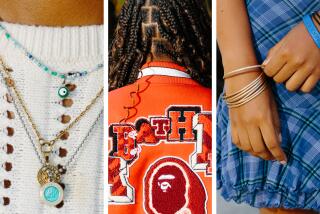Unmasking Identities
- Share via
Students in a fifth-grade class at Queen Anne Place Elementary School in Los Angeles unveiled a lot about themselves in a mask-making project.
“The primary benefit of mask-making is building self-esteem,” teacher Jean Ekstein said. “In the process . . . the children got an opportunity to know themselves better and accept themselves as they are, along with their special features and differences.”
The papier-mache mask project began with the children making impressions of their faces, protected by a coat of Vaseline, with newspaper and starch. When the impressions dried--with the help of a hair dryer--they were carefully lifted off the children’s faces and taped onto balloons with paper necks.
The mask construction process used newspaper, starch, book-binding tape and tempera and spray paints. Ear impressions were made by fitting starch-dipped tissue paper around the ear. Strips of paper formed the hair--curled strips for curly hair and small wet bits for Afro and corn-row styles.
After applying a coat of white primer paint, the children painted the masks into their likenesses. A protective coat of liquid plastic was the finishing touch.
“I feel very happy with the work I did,” said Sonia Monzon, 12. “I have never done a project like this. I truly like to see what we did with newspaper and paint. I feel everyone did a good job, and I am proud of it.”
Franklin Alumit, 11, was pleased with his work, although he did not think the mask resembled him. Felipe Flores, 12, looked upon his handiwork “like my twin brother.”
The students will receive more than self-satisfaction from the project. The masks, in an exhibit titled “My Mask Is Me,” are on display at the downtown Los Angeles Children’s Museum through July 30.
More to Read
Sign up for Essential California
The most important California stories and recommendations in your inbox every morning.
You may occasionally receive promotional content from the Los Angeles Times.













